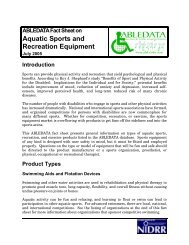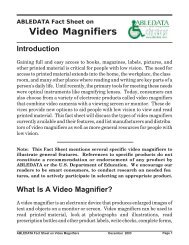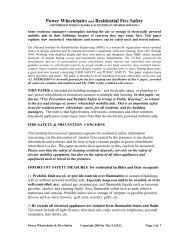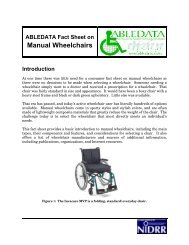Power Wheelchairs and User Safety - AbleData
Power Wheelchairs and User Safety - AbleData
Power Wheelchairs and User Safety - AbleData
Create successful ePaper yourself
Turn your PDF publications into a flip-book with our unique Google optimized e-Paper software.
legrests, back or headrest, often helpful for quadriparetics or quadriplegics. A few have<br />
optional elevating seats or st<strong>and</strong>-up features.<br />
Indoor Stair-Climbing power wheelchair models have been developed <strong>and</strong> tested over<br />
the past thirty years. The developers <strong>and</strong> manufacturers have generally been unable to<br />
obtain product liability insurance coverage <strong>and</strong>, thus, have not been able to market many<br />
of these products. Recently, the U.S. FDA approved yet another stair-climbing power<br />
wheelchair which has some very interesting <strong>and</strong> attractive design features. This stairclimber,<br />
as others before it, was designed for use in private homes <strong>and</strong> apartments as well<br />
as in public buildings. The earlier models, by other designers, were primarily for stairclimbing<br />
<strong>and</strong> were rather poor performers for general wheelchair use. The recently<br />
approved model appears to perform well in most wheelchair functions, as well as in<br />
climbing <strong>and</strong> descending stairs in private homes, in public buildings, <strong>and</strong> outdoors. These<br />
wheelchair models may or may not have electric elevation of legrests, back or headrest,<br />
often helpful for quadriparetics or quadriplegics.<br />
A BASIC DANGER OF STAIR-CLIMBING in a wheelchair is the fact that, if an occupied<br />
stair-climbing wheelchair falls down a flight of stairs (it could fall from near the top of a<br />
32-step stairway) then serious injury or death to the user is the likely. Others in the area<br />
may also be injured or killed.<br />
Each person considering the use of a stair-climbing power wheelchair should think about<br />
a lot of different variables, all of which interact with each other. These are just a few of<br />
the most significant of these important variables: (1) Does user have firm <strong>and</strong> immediate<br />
manual control of steering, braking <strong>and</strong> other wheelchair controls Examples: a<br />
paraplegic YES; a quadriplegic NO; users with MS or CP: variable – MAYBE – to what<br />
degree (2) Does user have sharp eyesight for spotting objects or defects on steps (3)<br />
Does user have engineering training or hobby experience in mechanics If not, can user<br />
underst<strong>and</strong> the dynamics of stair-climbing <strong>and</strong> learn to observe, analyze <strong>and</strong> think –<br />
before climbing stairs (4) Are the stairs to be climbed in the user’s home Are they<br />
stairs he has climbed <strong>and</strong> descended in the wheelchair time <strong>and</strong> time before Or, is it a<br />
new staircase not previously accessed (5) Has the user visually inspected the stairs<br />
before attempting to climb or descend them, for the presence of toys, clothing, <strong>and</strong> wet or<br />
damaged areas Any of these or other items could cause the wheelchair to fall. (6) Has<br />
the wheelchair user had someone else visually inspect the stairs for clutter, wet spots or<br />
damage before attempting to climb or descend (7) Has the wheelchair user been trained<br />
to climb <strong>and</strong> descend a particular flight of stairs by a professional such as the wheelchair<br />
engineer, or a therapist or a mobility trainer (8) Does the wheelchair user regularly<br />
climb or descend a new (to him) stairway on his own Or does he always have another<br />
experienced person evaluate the new stairway, first (9) Who is the first person to try<br />
climbing or descending a new stairway, in the power wheelchair The wheelchair user<br />
Or, his therapist, engineer or other proxy<br />
Age & Health Factors can be very significant to safety, both in preventing – <strong>and</strong> in<br />
surviving accidents. Examples: (1) Young paraplegic with normal upper body functions<br />
<strong>and</strong> strength. This fast moving person, with good eyesight, may well maneuver fast <strong>and</strong><br />
vigorously enough to prevent an accident. Even if his wheelchair turns over or falls over<br />
<strong>Power</strong> <strong>Wheelchairs</strong> & <strong>User</strong> <strong>Safety</strong> Copyright 2003 by The N.I.R.E. Page 3 of 8







